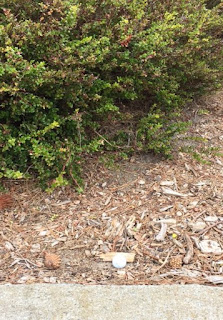I worked the US Women’s Amateur
Qualifyier at Sequoyah CC in the Oakland Hills this week.
This is an major event, as seven women would advance to the championship
at Rolling Green GC in Springfield, PA.
Looking down the 18th fairway from behind the green
I was
assigned checkpoint timing at the ninth and eighteenth greens. We used the USGA four hole checkpoint system,
meaning groups had to either meet their designated time or be within fourteen
minutes of the group ahead of them at four checkpoints: holes 4, 9, 13 and
18. The first time a group missed a
time, they would receive a warning, the second miss would mean a one stroke
penalty for each player, third would be two strokes for everyone, and the
fourth disqualification. The 9th
and 18th are only about 40 yards apart, but it was still
going to be an interesting and complicated day, bouncing back and forth, while keeping track of two groups at a time.
Over the
course of the day, we gave out about ten warnings for first misses, and two
groups were assessed one stroke penalties for the second miss. I gave I believe five of those warnings and
both penalties. This is not something
any Tournament Official wants to do (I think), but it is a part of the job, and
it is necessary to be comfortable doing so when needed.
Fortunately,
and to their credit, not a single player gave me any push back. Each player either simply nodded or said
thank you, and hustled to the next tee.
This was a great contrast to the MacKenzie last year, a men’s collegiate
event. That day, a player was told he
was being timed. He argued, and his
coach brought it up with at least two other officials, including me, over the
course of the rest of the round.
Things got
really interesting toward the end of the day.
The 10AM start times off both #1 and #10 had received warnings. They both came to their last holes in jeopardy
of missing a second time. The group finishing
at 18 got there first. As I approached
the green to watch them putt, clipboard and phone (atomic clock) in hand, one
of the caddies came over to me, and said “We need to hurry, don’t we?” I looked at the clock and said “Yes you
do.” He went back to the green, informed
the players, and they made their time by less than fifteen seconds. I got a big thank you when I gave them the
“safe” sign!
The other
group got to nine green a few minutes later.
I watched them putt, again with clock in hand, and as the last player
was getting ready to finish, I approached the caddy and told him “As soon as
that putt goes in, put the flagstick in.”
(Times are taken when the flagstick is replaced in the hole.) She finished, and he put the stick in with
seconds to spare. What would have
happened if he had dawdled, or if the flagstick was lying on the other side of
the green, and they missed by a few seconds?
I’ll just say I’m glad it didn’t happen.
Pace of play
is the bane of every Tournament Official’s existence. We continually see players not ready to when
it is their turn. We see players
seemingly not even start their decision process until it is their turn, both in
the fairway and on the green.
Professional golf gets much of the blame, as players grow up watching
and listening to player and caddie routinely spend two minutes discussing what looks like a most straightforward shot. At the US Junior
Am Qualifier a few weeks ago, a group somehow got to a checkpoint twenty-eight
minutes behind the group ahead, about twice the allowable time. Junior players need to be broken of that habit
early.
It was good
to see the players accept the warnings and get moving without any
argument. That showed that they are at
least aware of the issue.
Lucy Li, one of the qualifiers, teeing off on #1, her 10th hole








